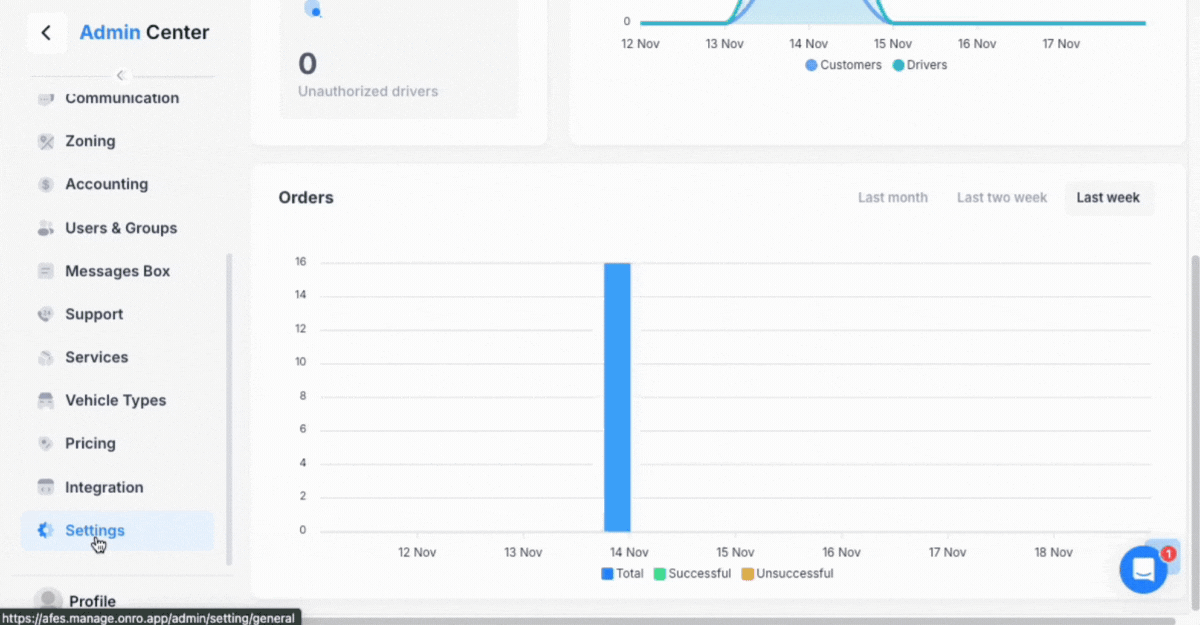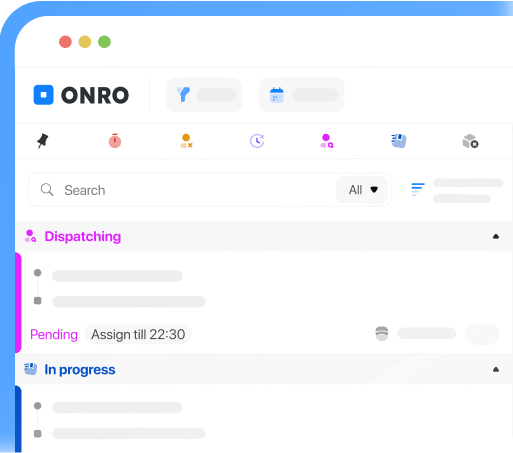Estimated time of arrival is fundamental to logistics as it enables a company to predict when a given delivery will happen. Therefore, it is possible to reduce errors in the delivery management process and this increases customer satisfaction.
In this post, we’ll explore the Estimated Time of Arrival, how it is calculated, and the different types (Fixed, Dynamic, and Probabilistic ETA). Also, we will discuss ETA vs ETD. Additionally, we’ll discuss its impact on customer satisfaction.
Try Onro for Free
Get your free access to the Onro All-in-one Delivery Management Software.
What is Estimated Time of Arrival?
ETA (Estimated Time of Arrival) relates to the time expected for the vehicle, courier, or package to reach its destination. ETA is an important aspect of the transportation and logistics industry. The concept of the estimated time of arrival is crucial in aviation, shipping, and even in the relatively advanced field of road transport.
Due to the advent of technology, computer systems, including computers in cars and GPS applied for tracking and scheduling tools have emerged, which enable companies to calculate ETA and constantly update them. This in-vogue capability allows the companies to communicate to clients when items are likely to come in handy and even plan in the event of a slowdown.
Different Types of Estimated Time of Arrival: Fixed ETA, Dynamic ETA and Probabilistic ETA
ETA shipping meaning (Estimated Time of Arrival) comes in varying types:
Planned ETA (Fixed ETA or Scheduled ETA)
Just a few years ago, logistics ETA tools reported the arrival time of an order with a fairly fixed ETA. This ETA was an expected time of arrival defined and kept unchangeable in time, regardless of the conditions. This planned ETA is optimal for a more or less steady state where the moment of arrival can be reasonably precisely predicted.
Fixed ETA is primarily used in predictable routes, such as circular sailing. In Onro’s delivery management software, you can set a fixed ETA time. But Onro has another fantastic option discussed in the next section, dynamic ETA feature.
Dynamic ETA (Adjusted ETA or Real-Time ETA)
The ETA adjusted to real-time conditions to be changed, particularly desirable in opposition to “Fixed ETA” for example in the case of land transportation.This new improvement in ETA is readjusted every optional minute based on the driver’s last GPS location. You can set an update ETA time every 2 or maybe more minutes to change it based on maps to consider possible navigation around traffic, weather conditions, and other factors. You can access this option in your free demo of the Onro in the management console:

On the other hand, live tracking will offer dynamic ETAs to customers, whereas planned Estimated Time of Arrival will appear on the system’s dashboard for comparison. This functionality of the “Customer Portal” on the Onro system enhances the accuracy of the systems and arrival predictions for customers and ETA logistics organizations.
Probabilistic ETA or Estimated ETD
A range of arrival times that is estimated to be within a certain degree of probabilistic certainty and is often used in cases of uncertainty, like in long international sea voyages or delayed deliveries.
How Onro Increases On-Time Delivery Rates with ETA Tracking
One easy way to increase the on-time delivery rate is using the Onro system. That is informing your clients about the time frame they can expect delivery vehicles to arrive, no matter if it is uncertain ETA or time joint is the first thing that will work as a growth to your on-time delivery rates.
1. Tracking Driver’s Location and ETA in Real-Time
For every minute on the road, Onro uses the present status of the driver to detect the closest possible location coordinates that will correspond to zero distance to the customer.
2. Types of Delivery Notifications
In the Onro’s management console, you can configure different types of notifications depending on the order status, such as four sections: Order, Driver, Support, or Customer. So, in the configuration, you can define different automated notifications to be sent to your customers and update them with the tracking link and ETA.
3. Dynamic ETA Adjustments Based on External Factors (Weather, Traffic, etc.)
With the Estimated Time of Arrival, the clients will obtain the notification series indicating their position in the queue with the help of dynamic business hours feedback. Such notification can be received by a customer at the moment when a driver starts moving to the destination.
If factors like weather, traffic, or other force majeure events cause delays, customers will see updated information, providing much greater transparency.
Comparing Features of Fixed, Dynamic and Probabilistic ETA
| Feature | Fixed ETA | Probabilistic ETA | Dynamic ETA or Adjusted ETA |
|---|---|---|---|
| Consistency | ETA remains fixed, even with route changes. | ETA changes based on data, with some uncertainty. | ETA changes with real-time data like traffic or weather. |
| Better Planning | Helps compare planned vs. actual arrival times. | Helps with flexible planning using probability. | Offers flexibility with real-time updates for adjustments. |
| Optimization | Optimizes route and fleet using fixed times. | Allows optimization based on estimated probability. | Optimizes costs and work hours with real-time data. |
| Transparency | Provides a predictable timeframe. | Offers transparency with probabilistic ETA predictions. | Enhances transparency with live tracking updates. |
| Performance | Not applicable for tracking performance directly. | Less focused on performance tracking. | Monitors driver performance with real-time tracking. |
| Accuracy | ETA remains constant for a fixed timeframe. | Offers probability-based accuracy, less precise. | Provides the most accurate predictions with real-time data. |
What Is the Estimated Time of Departure?
The Estimated Time of Departure (ETD) refers to the time that the transporter leaves the item’s origin and moves it to its delivery address. It is possible to determine the next step in the optimization process by knowing when goods are available for shipping at the time of getting off from the warehouse, hub, center, or another place.
| Definition | Notes | |
| ETA (Estimated Time of Arrival) | Estimated Time of Arrival (ETA) refers to the predicted time when a vehicle or passenger will reach its intended destination. | Provides an arrival estimate; generally clear in its meaning. |
| ETD (Estimated Time of Departure) | The estimated time when a vehicle or package will leave a storage facility or starting location. | Refers to the start of a journey or shipment process. |
| ETD (Estimated Time of Delivery) | The estimated time of delivering a package or product to the consignee. | Refers to the end of the delivery process; often confused with ETA due to its meaning as a final point in the logistics chain. |
Calculate Estimated Time of Arrival
Some factors such as the distance between your current and final points, speed, and traffic are significant when ETA calculation.
Simply using the equation Time = Distance / Speed provides a rough idea. However, other factors like gas, weather, and intermission stops also need to be taken into account.
More recent evaluations tend to use the modern technology available that is, real-time data by GPS and traffic monitoring. In addition, the system of values is Dynamic ETA Arrival, the value of this component is continuously changed to achieve maximum accuracy under the altered conditions.
This means that logistics providers can provide clients with service-level agreements that guarantee times of delivery among particular areas. The main servicing area involved in dynamic forecasting of ETA estimates is the shipper, particularly, logistics brokerage providers enabling final mile delivery fulfillment.
Why is Estimated Time of Arrival Accuracy Important?
Real-time tracking, along with periodical delivery notification updates, plays a significant role in improving customer satisfaction by providing customers with the necessary groundwork to steady the delivery of their purchases. This is necessary especially when you have to deal with the ‘Where is my order?’ (WISMO) questions that are detestable to the service provider.
Furthermore, it is also proven that more than 30% of all live chat interactions and more than 50% of all customer service calls are constantly WISMO-oriented. Businesses may reduce those tremendously and enhance customer services and their reputation. Indeed, it is a fact that customers who are not only acknowledged but also respected are far more likely to come back for more business.
Without proper delivery service, up to 68 percent of customers refused to visit again. Sending such a positive statement is another alternative. It is as well possible to reduce costs for customer service departments while maintaining, or improving, levels of customer loyalty, by using exact time estimates and statistics. Consequently, the more precise the estimations are, the more satisfied the customers tend to be with the service provided.
Conclusion
The Estimated Time of Arrival (ETA) is a solution for all operations like courier and postal services, transport, cargo delivery, and taxi services. Using Onro’s ETA feature substantially increases the degree of precision in delivery, increases customer satisfaction, and reduces WISMO calls. By using real-time tracking and a dynamic system of ETA Onro provides transparent and accurate updates hence enabling on-time deliveries. This also brings down some costs related directly to the customer service.
Try Onro for Free
Get your free access to the Onro All-in-one Delivery Management Software.




